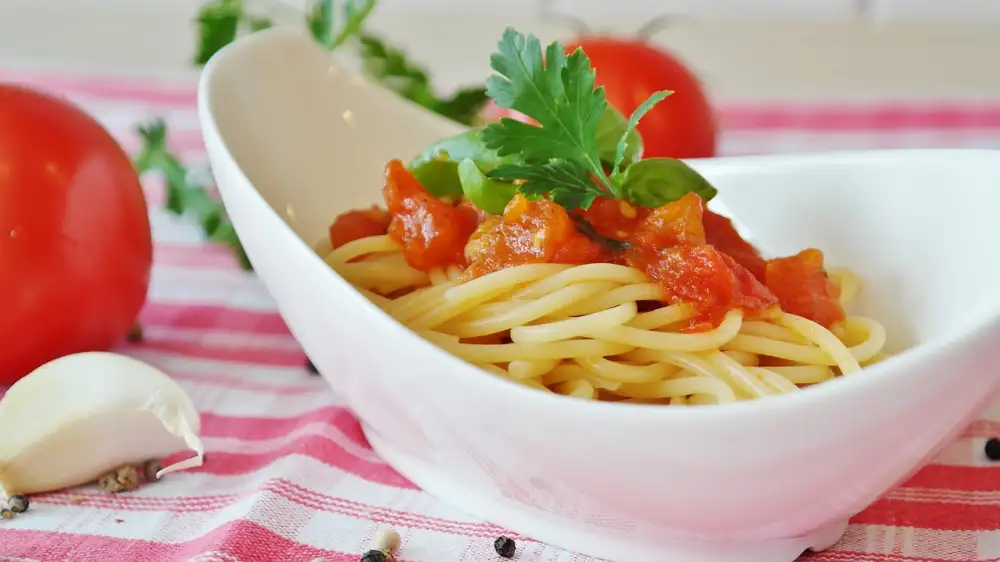Authentic Italian Ragu Recipe: A Savory Delight for Your Taste Buds

Ragu, a traditional Italian meat-based sauce, is a culinary masterpiece that has been passed down through generations. This rich and savory sauce is known for its depth of flavor and tender chunks of meat. Whether served over pasta or as a filling for lasagna, Ragu is sure to delight your taste buds and transport you to the heart of Italy. In this article, we will explore the authentic Italian Ragu recipe and guide you through the process of creating this delectable dish in your own kitchen. Get ready to embark on a culinary journey that will leave you craving for more!
Ingredients needed for Ragu
To create this authentic Italian masterpiece, you will need the following ingredients:
- 1 pound of ground beef
- 1 pound of ground pork
- 1 onion, finely chopped
- 2 carrots, finely chopped
- 2 celery stalks, finely chopped
- 4 cloves of garlic, minced
- 1 can (28 ounces) of crushed tomatoes
- 1 cup of red wine (such as Chianti)
- 2 tablespoons of tomato paste
- 2 tablespoons of olive oil
- 1 teaspoon of dried oregano
- 1 teaspoon of dried basil
- Salt and pepper to taste
These ingredients work together harmoniously to create a rich and flavorful ragu that will tantalize your taste buds.
Step-by-step instructions for making Ragu
a. Start by preparing the meat and vegetables. Dice 1 onion, 2 carrots, and 2 celery stalks. Finely chop 4 cloves of garlic. Cut 500g of beef into small cubes.
b. Heat olive oil in a large pot over medium heat. Add the beef cubes and brown them on all sides until they develop a rich caramelized color.
c. Once the meat is browned, add the diced onion, carrots, celery, and chopped garlic to the pot. Stir well and cook for about 5 minutes until the vegetables soften.
d. Pour in 1 cup of red wine and let it simmer for a few minutes until it reduces slightly. Then add 800g of crushed tomatoes, 2 tablespoons of tomato paste, and 1 cup of beef broth.
e. Reduce the heat to low and let the sauce simmer for at least 2 hours, stirring occasionally to prevent sticking. This slow cooking process will allow the flavors to meld together beautifully.
f. After simmering, taste the sauce and adjust the seasoning with salt and pepper according to your preference.
Remember to be patient during each step as this is what gives Ragu its depth of flavor!
Preparing the meat and vegetables
To prepare the meat and vegetables for your authentic Italian ragu, start by finely chopping one onion, two carrots, and two celery stalks. These aromatic vegetables will add depth of flavor to your sauce. Next, mince three cloves of garlic and set aside. For the meat, you will need 500 grams of ground beef and 250 grams of ground pork. It is important to use a combination of both meats to achieve the perfect texture and taste in your ragu. Once all the ingredients are prepped, you are ready to move on to the next step in creating this savory delight for your taste buds.
Browning the meat
To achieve the rich and deep flavors that make Ragu so irresistible, it is crucial to properly brown the meat. This step adds a caramelized crust to the meat, enhancing its taste and texture.
Start by heating a large, heavy-bottomed pot over medium-high heat. Add a drizzle of olive oil and allow it to heat up. Place the meat in the pot, making sure not to overcrowd it. This will ensure that each piece gets evenly browned.
Let the meat cook undisturbed for a few minutes until it develops a golden-brown crust on one side. Flip each piece using tongs or a spatula and repeat the process on the other side. The browning process should take about 5-7 minutes in total.
Once all sides are nicely browned, remove the meat from the pot and set it aside. Do not worry if there are some brown bits stuck to the bottom of the pot – these will add incredible flavor to your sauce later on.
Browning the meat is an essential step in creating an authentic Italian Ragu. It adds depth and richness to the final dish, elevating it from ordinary to extraordinary.
Adding the vegetables and aromatics
After browning the meat to perfection, it's time to add the vegetables and aromatics to elevate the flavors of your ragu. Start by finely chopping an onion, a carrot, and a stalk of celery. These three ingredients form the holy trinity of Italian cooking known as "soffritto."
In a large saucepan, heat some olive oil over medium heat and add the chopped vegetables. Sauté them until they become soft and translucent, which should take about 5 minutes. This step is crucial as it helps release their natural sweetness and adds depth to the sauce.
Next, it's time to introduce the aromatics that will infuse your ragu with irresistible fragrance. Mince a few cloves of garlic and add them to the pan with the vegetables. Stir everything together for about a minute until you can smell the delightful aroma wafting through your kitchen.
To enhance the flavor profile even further, you can also add some dried herbs such as oregano, thyme, or rosemary at this stage. These herbs bring their unique earthy notes that perfectly complement the richness of the meat.
Once all the vegetables and aromatics are well combined, it's time to move on to the next step: simmering the sauce. This will allow all the flavors to meld together into a harmonious symphony that will delight your taste buds. So let's move on to that exciting part!
Simmering the sauce
Simmering the sauce is a crucial step in making an authentic Italian ragu. Once you have added the vegetables and aromatics to the browned meat, it's time to let the flavors meld together by simmering the sauce. This slow cooking process allows all the ingredients to release their natural juices and infuse into the sauce, creating a rich and savory flavor profile.
Cover the pot with a lid and reduce the heat to low. Let the sauce simmer gently for at least 2 hours, but preferably longer if time permits. The longer you simmer, the more tender and flavorful your ragu will become. Stir occasionally to prevent sticking, and check on the consistency of the sauce. If it starts to thicken too much, you can add some water or broth to thin it out.
During this simmering process, magic happens as all the flavors blend together harmoniously. The meat becomes incredibly tender, almost melting in your mouth, while the vegetables break down and contribute their essence to create a robust and luscious sauce.
As you patiently wait for your ragu to reach its full potential, your kitchen will be filled with tantalizing aromas that will make your taste buds dance with anticipation. The slow simmering process is what truly sets apart an exceptional ragu from a mediocre one.
Remember, patience is key when it comes to simmering your ragu sauce. Allow enough time for all those wonderful flavors to develop fully before serving it over pasta or polenta. Trust me; it will be worth every minute spent waiting as you savor each bite of this delectable Italian masterpiece!
Adjusting the seasoning
Adjusting the seasoning is a crucial step in making the perfect Italian ragu. After simmering the sauce for a while, taste it and assess the flavors. If you find that the sauce lacks depth or richness, add a pinch of salt to enhance the overall taste. For a touch of sweetness, you can add a teaspoon of sugar or a splash of red wine. To balance out any acidity, consider adding a tablespoon of tomato paste. Remember to taste and adjust gradually, as you can always add more seasoning but cannot take it away. The goal is to achieve a well-balanced and harmonious flavor profile that will truly delight your taste buds.
Serving suggestions for Ragu
Serving Suggestions for Ragu:
Once your authentic Italian ragu is ready, it's time to think about how to serve this savory delight. Traditionally, ragu is served with a hearty pasta such as tagliatelle or pappardelle. The thick and rich sauce pairs perfectly with the wide ribbons of pasta, allowing the flavors to meld together beautifully.
For a truly indulgent experience, top your plate of ragu with a generous sprinkle of freshly grated Parmesan cheese. The salty and nutty notes of the cheese complement the robust flavors of the sauce.
If you're looking for a lighter option, try serving your ragu over polenta or creamy mashed potatoes. The creamy texture of these side dishes provides a wonderful contrast to the meaty ragu.
For an extra touch of freshness, garnish your plate with some chopped parsley or basil. This adds a pop of color and herbaceousness that enhances the overall presentation and taste.
Don't forget to accompany your meal with a glass of full-bodied red wine such as Chianti or Barolo. The tannins in these wines help cut through the richness of the sauce and elevate the dining experience.
Remember, ragu is meant to be enjoyed slowly and savored. So gather your loved ones around the table, share stories, and relish every bite of this comforting Italian classic.
Variations and tips for making Ragu
- For a richer flavor, you can add a splash of red wine to the sauce while simmering.
- If you prefer a spicier taste, try adding a pinch of red pepper flakes or a dash of hot sauce.
- To make a vegetarian version, substitute the meat with mushrooms or lentils for a hearty alternative.
- Experiment with different types of meat such as pork, veal, or even game meats like venison for unique flavors.
- Don't rush the browning process as it adds depth and complexity to the sauce. Take your time to achieve that perfect caramelization.
- Leftover ragu can be used in various dishes like lasagna, stuffed peppers, or even as a topping for pizza.
- Remember that ragu tastes even better the next day as the flavors have had time to meld together. So consider making it ahead of time for an even more delicious meal.
In conclusion, the authentic Italian Ragu recipe is a savory delight that will surely satisfy your taste buds. With its rich and flavorful sauce, tender meat, and aromatic vegetables, this dish is a true masterpiece of culinary artistry. Whether served over pasta or enjoyed with crusty bread, Ragu is a comforting and satisfying meal that will transport you straight to Italy. So why not try your hand at making this traditional Italian dish and delight your senses with the flavors of Ragu?
Published: 29. 11. 2023
Category: Recipes



